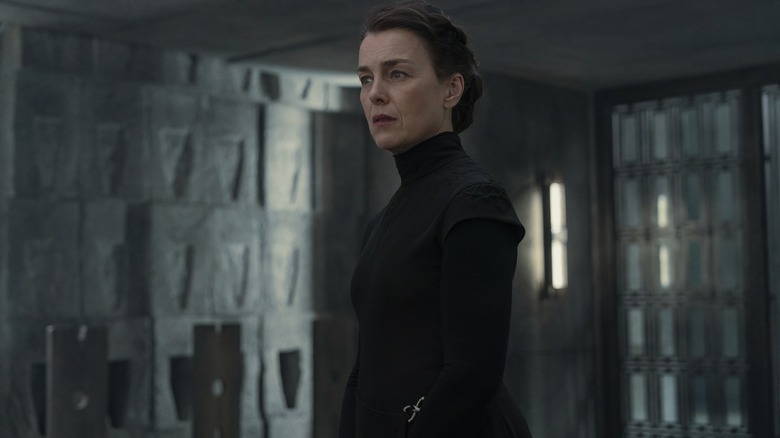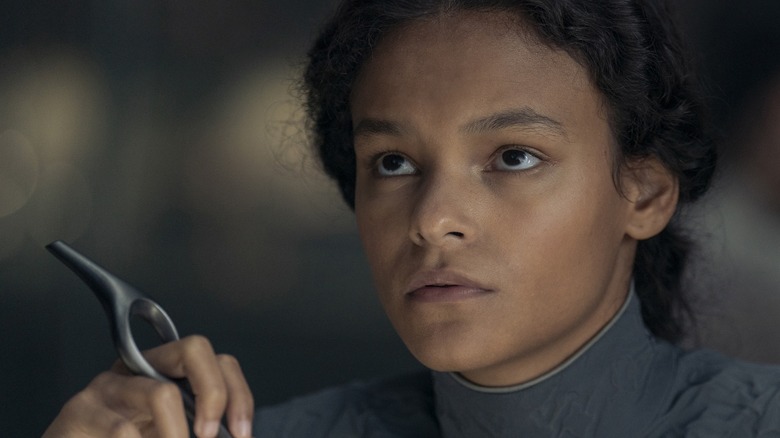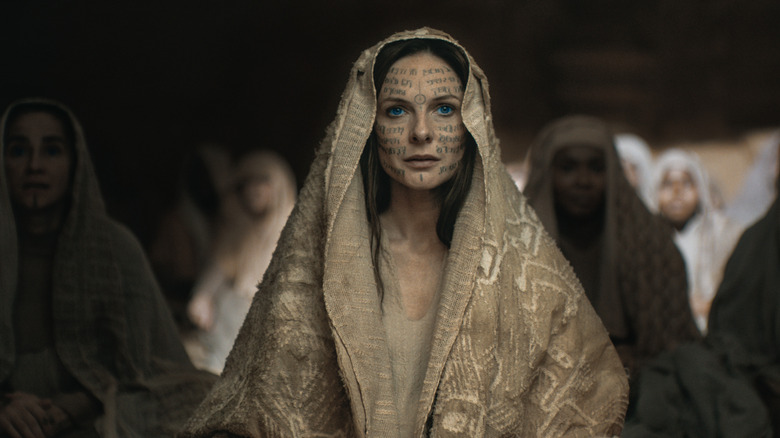Dune: Prophecy Clarifies One Of The Most Confusing Parts Of The Movies
This post contains spoilers for the latest episode of "Dune: Prophecy."
It'd be the understatement of the century to say that "Dune" lore is not for the faint of heart. Spanning millennia (both before and after the birth of Paul Atreides), various adaptations of author Frank Herbert's sci-fi touchstone over the decades have barely even scratched the surface of what this rich, sprawling in-universe history has to offer — and that includes both of Denis Villeneuve's well-received blockbusters. "Dune: Prophecy" represents the next step to further flesh out this world, which was on display as early as last week's premiere episode and its depiction of the Butlerian Jihad. Episode 2, titled "Two Wolves," keeps that trend going. This time, however, it does so by adding some much-needed clarity to what might be one of the more confusing aspects of the recent movies.
With so many characters and subplots to keep track of and only so much screen time to go around, it stands to reason that "Dune" adaptations would have to pick their battles carefully. "Dune: Part Two" faithfully recreated one of the most significant moments from the novel, when Lady Jessica (Rebecca Ferguson) is compelled to ingest the so-called "Water of Life" in order to become a Reverend Mother among the indigenous Fremen. While casual audiences had little choice but to just go along with all the weirdness, book readers know that the sequel left out a ton of details from this ritual that fully explained why this was so dangerous in the first place.
That's where "Dune: Prophecy" is once again filling in the gaps, adding even more context to what we already know about the Water of Life.
Dune: Prophecy depicts one of the earliest Water of Life rituals ... with disastrous results
It's one of the oldest tricks in screenwriting: If you want to emphasize how important certain rules are, simply show your characters breaking them ... and the consequences that must follow. In the world of "Dune," following rules and rituals and traditions is as crucial as it gets. Tula Harkonnen (Olivia Williams), already so unsettled by the horrific death of fellow Bene Gesserit and Reverend Mother Kasha (Jihae) in the waning moments of the premiere, learns this the hard way when she must confront an even scarier proposition. While her sister and Mother Superior Valya Harkonnen (Emily Watson) sets out to Selusa Secondus so she can deal with the chaos embroiling House Corrino in person, Tula is left behind to help out in a very different way. Her star pupil, the young Sister Lila (Chloe Lea), holds the key to unlocking the prophecy spoken by the previous Mother Superior Raquella (Cathy Tyson) on her deathbed. And she'll have to break every single Bene Gesserit norm in order to do it.
Nowhere is that more clear than in the Water of Life ceremony, which "Dune: Prophecy" refers to as "The Agony." Early on in the episode, Valya all but forces Tula to put her student at extreme risk by ushering in this ritual long before they had originally planned to do so. It's revealed that Lila is actually the great-great-granddaughter of Raquella herself, meaning the Water of Life — a poison secreted by Arrakis sand worms that, when properly ingested, will awaken her genetic memory passed down by her ancestors — will provide them with the answers they need. Lila's horrified reaction underlines the point that she has many, many more years of training to undergo before even coming close to feeling ready. But, with present circumstances as dire as they are, there's little choice but to forge ahead anyway.
As Tula and Lila soon find out, the results are nothing short of deadly.
How Dune: Prophecy makes Dune: Part 2 even better
Considering how much mileage "Dune: Part Two" had to cover throughout its already-lengthy runtime, perhaps it was inevitable that some of the nerdier and more obscure details from the book would have to be left unexplained. The Water of Life sequence with Lady Jessica (and, later on, Paul Atreides himself) is a chief example of this. The sequel conveys the broad strokes of the danger and stakes inherent in this process, sure, and Paul's eventual transformation into an even more Messianic figure after ingesting the poison is given all the dramatic weight it deserves. Still, something can't help but feel missing — something "Dune: Prophecy" attempts to pick up the slack on.
Throughout several tense conversations, Tula and Lila make it clear to viewers that this "Agony" is no joke. Where "Dune: Part Two" explained the rote mechanics of this act (the Bene Gesserit must physically transform the poison into a harmless substance on a molecular level using their mind), "Dune: Prophecy" takes a much more introspective approach by actually showing what this process "looks" like from within. Lila is transported to some liminal space that looks eerily like catacombs, surrounded by the faceless phantoms of her many ancestors. Although predominantly focused on the emotional journey of Lila, it's left implied that Lady Jessica and Paul Atreides must've gone through a similar experience — one that makes it much more apparent why their particular actions were so dangerous in the first place.
Lila doesn't appear to survive the Agony, subsumed by the memory of her ancestor Reverend Mother Dorotea (Camilla Beeput), whom young Valya had killed with the Voice back in the flashback shown in the premiere. When paired with "Dune: Part Two," this scene in the HBO series functions as additional background material to help contextualize what could've gone so wrong all those years later with Jessica and Paul Atreides. New episodes of "Dune: Prophecy" air on HBO and Max every Sunday.


